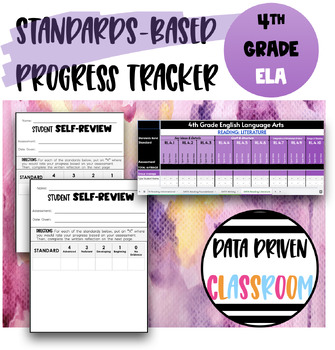Digital Standards-Based Tracker | 4th Grade ELA (Student Self-Reported Grades)
- PDF
- Google Apps™

Description
GET YOUR STUDENTS INVOLVED IN PROGRESS-MONITORING!
This resource provides links to an editable student self-reported grades worksheet template on Google Slides and a standards-based tracking workbook on Google Sheets for teachers to monitor student progress on each ELA standards throughout the year.
EDITABLE WORKSHEETS:
The editable Google Slides presentation includes two versions of a student self-review worksheet
- Teachers copy and paste the each standard the assignment assessed into a pre-made chart.
- Print for students to add to their data binder, or share with students digitally.
- Students rate their performance from either a 4-1 or 4-0 scale, following the standards-based proficiency measures.
- OPTIONAL: A reflection page is included after the scale, so students can write a blurb on what skills they were proficient on and what skills they should focus on for next time.
Step-by-step directions for use are included on the first slide of the presentation.
TEACHER TRACKER GOOGLE SHEETS:
The editable Google Sheets workbook includes a page for each of the Common Core State Standards strands for 4th Grade
- Reading Literature
- Reading Informational
- Writing
- Speaking & Listening
- Language
- Reading Foundational
You can use this spreadsheet to input student data, either how they rated themselves on each standard, how you rated them, or a combination of both. There are multiple columns below each standard if you assess the standards multiple times throughout the year.
Each spreadsheet also calculates the averages for each group AND the average across all groups.
Easy to adjust to your classroom needs (interventionist, classroom teacher, PLC comparing data among classrooms)
PAIRS WELL WITH
These forms can be kept in the same location as the PDSA forms so students can easily access all of their self-reported assessments throughout the year.
Please consider leaving a review after purchase! This helps more teachers decide whether a resource is valuable to them or not. I'm confident you will see the value in this highly-effective resources for your classroom!
QUESTIONS? COMMENTS? Email datadrivenclassroomTPT@gmail.com
© Copyright, Hannah Graff, 2022.
Purchase of this resource entitles the buyer to digital use for ONE classroom. Please do not share the link with other teachers, as this is a violation of the Digital Millennium Copyright Act. If purchasing to use with a group, add multiple licenses at a discount. Thank you for supporting a young teacher mom!



